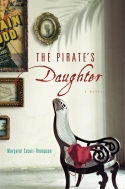- Categories:
Hollywood Glamour & Jamaican History Intertwine in Multigenerational Saga
 Margaret Cezair-Thompson Photo: Marion Ettlinger |
A youthful interest in history came naturally to Margaret Cezair-Thompson, author of the number-one October Book Sense Pick The Pirate's Daughter (Unbridled). When she was growing up in Jamaica, in the 1960s and '70s, her father -- a noted constitutional and human-rights barrister for emerging countries, who became a member of the Jamaican government -- was helping shape that island-nation's destiny.
Cezair-Thompson's passion for the past was complemented by a love for 19th-century fiction (Jane Austen, Thomas Hardy, Thackeray). She also loved poetry.
"My father really was the one who encouraged the poetic side," recalled Cezair-Thompson, who now teaches literature and creative writing at Wellesley. "He would bring books of poetry to me, and we would read poetry together. My mother was more the fiction side: always had a book in her hand, always taking me to the library."
 Cezair-Thompson wrote poetry in high school -- and then discovered Virginia Woolf's To the Lighthouse. "I just never knew you could do that sort of thing with prose," she said. "The capacity for collapsing time, and shifting from one point-of-view to the next ... that great ability Woolf had really impressed me. That was when I started trying to write fiction."
Cezair-Thompson wrote poetry in high school -- and then discovered Virginia Woolf's To the Lighthouse. "I just never knew you could do that sort of thing with prose," she said. "The capacity for collapsing time, and shifting from one point-of-view to the next ... that great ability Woolf had really impressed me. That was when I started trying to write fiction."
Cezair-Thompson left Jamaica for New York at age 19, to study at Barnard and then earn a Ph.D. at the City University of New York. At Barnard, the Armenian-American novelist and historian Marjorie Housepian Dobkin gave her much assistance and inspiration. "She was a great writing teacher, and she probably did more than anyone I can think of to encourage and teach me the craft," said Cezair-Thompson. "I became very serious about trying to become a writer."

Now, in her second novel, Cezair-Thompson has written a much different Jamaica-based story, one far removed from her personal history. The Pirate's Daughter is a 30-year-saga of a Port Antonio, Jamaica, mother and child whose lives are greatly affected by their encounters with movie star Errol Flynn, who in fact visited Jamaica often in the last years of his life.
"I didn't want to repeat myself," the author said with a chuckle, about the writing of her second fiction work. "But a lot of the things that I am genuinely interested in came out again with this novel -- which is that I just deeply love history. Once I start looking at a subject, I can't help looking at whatever interesting coincidences in history might pop up."
Port Antonio was full of such fascinating lore, Cezair-Thompson found. Captain Bligh had been there after the mutiny on the Bounty. Pirates had operated in and around the port. The worldwide banana trade and the United Fruit Company both had their origins in Port Antonio, Jamaica.
And then there was Errol Flynn.
"It was very strange," said the author. "Once I had the opening images in my mind, and the place in mind ... it was like he just stepped forward and said, 'But I'm here, too! I lived here.' And I thought, 'Whoa! That's wonderful!'"
Though the characters with whom the movie-star interacts in her novel are fictitious, Cezair-Thompson said, much of the Flynn material she used was a matter of record: "The facts surrounding Flynn are so much more interesting than anything anyone could ever make up. You know, like the fact that he really was caught in a storm, and his boat wrecked, and he accidentally arrived in Jamaica -- that's true. And his love of Navy Island [off Port Antonio], and of Jamaica, and of the sea ...
"Of course I tried to reconstruct him as a real, living character -- you know, giving him thoughts, and a voice. I didn't want him to be the sort of sensational tabloid-creature he became in real life ... I actually found him a sympathetic character: a person who was really struggling to find his right place in the world -- and making a lot of mistakes while he was doing it."
Similar things might be said of her novel's principal figures: a mother coming to terms with fateful events and decisions of her younger years and a daughter making her way through a complicated and layered racial and cultural heritage.
"The search for the father is one result of the search for identity, and a search for place," Cezair-Thompson said, regarding her new novel's larger themes. "The ways in which who you are have so much to do with ... where you go, or where you want to be."
May, the daughter of the book's title, in many ways represents Jamaica to her, the writer said. "And Flynn in many ways is symbolic of one part of Jamaican history, of what came to the island: European and American adventurers, and the pirates themselves. And the way the island -- like May -- and islands like Jamaica, are semi-abandoned.... So I was just very interested in the way May's inheritance -- her legacy -- is also Jamaica's."
May, "the pirate's daughter," in time discovers her own personal treasure -- one that the author declined to describe. Having constructed this engrossing treasure-map of a novel, she said, "I leave that to the reader to find." --Tom Nolan

